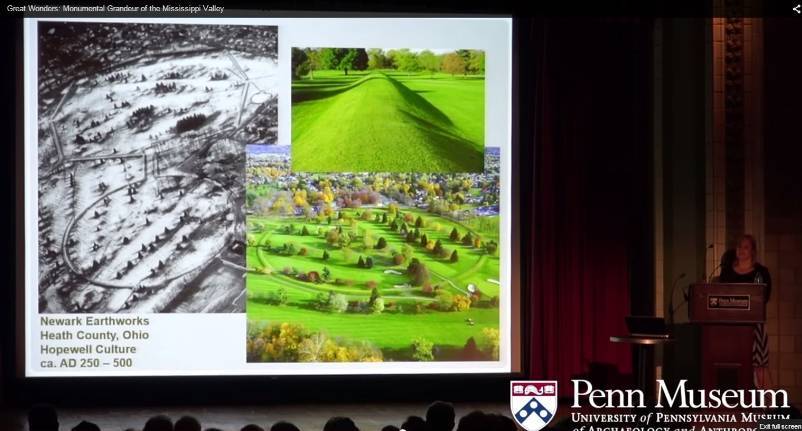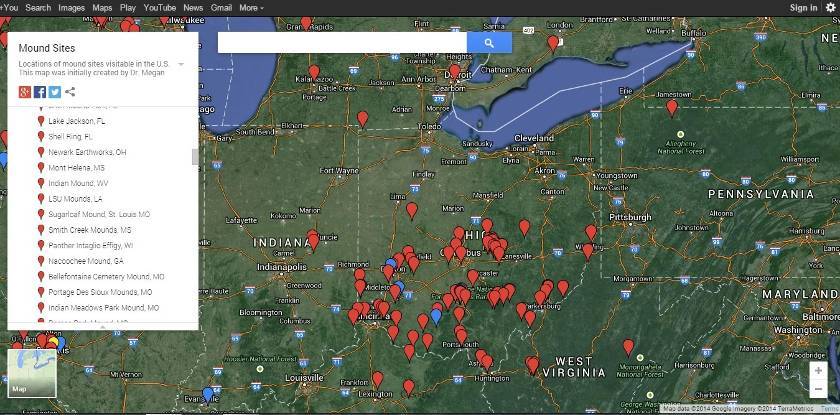 The Penn Museum at the University of Pennsylvania is sponsoring a series of public lectures on Great Wonders of the World. Appropriately, the first in the series is a program by University of Pennsylvania archaeologist Megan Kassabaum on the Monumental Grandeur of the Mississippi Valley. Her November 5th presentation is available online on the Penn Museum’s Blog.
The Penn Museum at the University of Pennsylvania is sponsoring a series of public lectures on Great Wonders of the World. Appropriately, the first in the series is a program by University of Pennsylvania archaeologist Megan Kassabaum on the Monumental Grandeur of the Mississippi Valley. Her November 5th presentation is available online on the Penn Museum’s Blog.  Kassabaum’s knowledge of Ohio’s sites isn’t as complete as it is for the regions where she has undertaken her own research. For example, she appears to think the Newark Earthworks are located along the Scioto River in Ross County rather than along Raccoon Creek in Licking County. (Apparently, she has mistaken High Bank Works for Newark’s Octagon Earthworks.) But such gaffes can happen whenever you are presenting on regions or time periods that are not part of your own areas of research and rather than criticize Kassabaum I would rather applaud her effort to present a big picture overview rather than one more narrowly focused on her particular area of expertise. Overall, Kassabaum’s presentation is entertaining and informative and she has many interesting insights to offer on the monumental grandeur of the Mississippi valley — from ancient times to the modern Cherokee. In a comment to the blog, Kassabaum adds the following note: “I have been working on a map of visitable mound sites in the U.S. The map has crowd-sourced and thus exact locations are not guaranteed. If you know of additional sites, please add only those that are open to the public (i.e., in parks, archaeological preserves, etc.) or are viewable from public land (i.e., privately owned sites with historical markers on the road).” This will be a useful resource though, like many crowd-sourced projects, there are mistakes. For example, Serpent Mound is identified as a Middle Woodland earthwork rather than as a Late Prehistoric or Early Woodland effigy and Fort Ancient is listed as a Mississippian rather than a Middle Woodland hilltop enclosure.
Kassabaum’s knowledge of Ohio’s sites isn’t as complete as it is for the regions where she has undertaken her own research. For example, she appears to think the Newark Earthworks are located along the Scioto River in Ross County rather than along Raccoon Creek in Licking County. (Apparently, she has mistaken High Bank Works for Newark’s Octagon Earthworks.) But such gaffes can happen whenever you are presenting on regions or time periods that are not part of your own areas of research and rather than criticize Kassabaum I would rather applaud her effort to present a big picture overview rather than one more narrowly focused on her particular area of expertise. Overall, Kassabaum’s presentation is entertaining and informative and she has many interesting insights to offer on the monumental grandeur of the Mississippi valley — from ancient times to the modern Cherokee. In a comment to the blog, Kassabaum adds the following note: “I have been working on a map of visitable mound sites in the U.S. The map has crowd-sourced and thus exact locations are not guaranteed. If you know of additional sites, please add only those that are open to the public (i.e., in parks, archaeological preserves, etc.) or are viewable from public land (i.e., privately owned sites with historical markers on the road).” This will be a useful resource though, like many crowd-sourced projects, there are mistakes. For example, Serpent Mound is identified as a Middle Woodland earthwork rather than as a Late Prehistoric or Early Woodland effigy and Fort Ancient is listed as a Mississippian rather than a Middle Woodland hilltop enclosure.  Brad Lepper
Brad Lepper